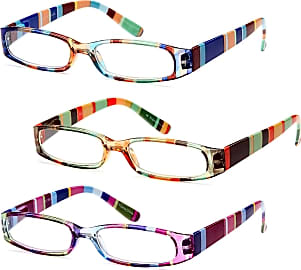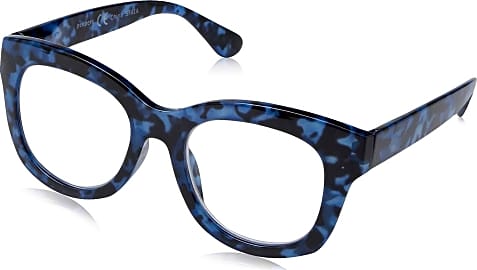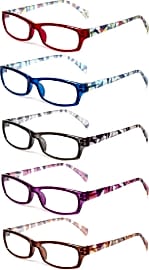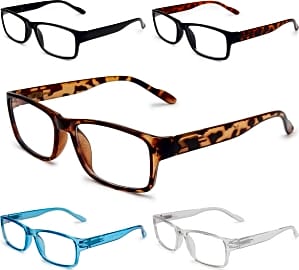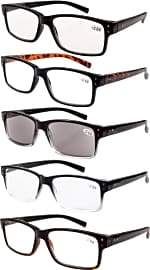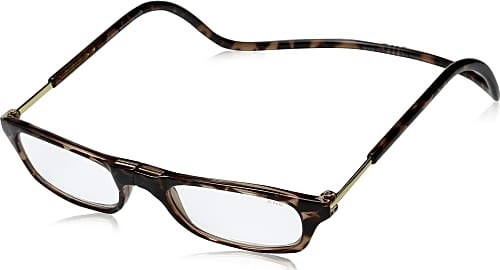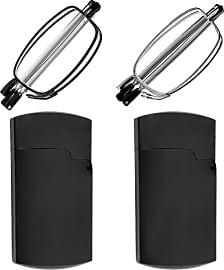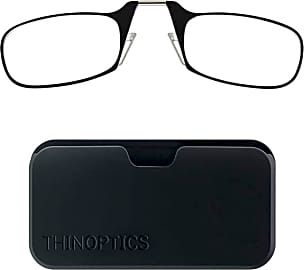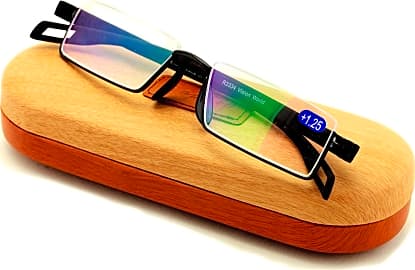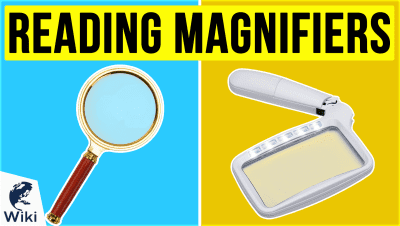The 10 Best Reading Glasses

This wiki has been updated 41 times since it was first published in March of 2016. If you find that you’re starting to hold books, newspapers, and menus at arm's length, it may be time for you to consider a pair or two of these handy reading glasses. They come in an array of styles and colors to suit any facial shape and personality, and will bring everything into sharp focus, including the annoyingly tiny print on many user manuals and product ingredients labels. When users buy our independently chosen editorial recommendations, we may earn commissions to help fund the Wiki.
Editor's Notes
November 08, 2020:
For this update, we've added two affordable five-packs of stylish spectacles. We love the variety of colors you get with the Gaoye Spring Hinge, which includes styles that look serious, classic, playful, and mod. The Kerecsen Fashion Five-Pack also provides multiple colors, or you can go all-in on one look and order a handful of the same exact glasses. Another new pair are the ThinOptics Universal Pod, which have an innovative design with no earpieces.
The Urban Boundaries Classic Spring have been removed because of their poor-quality case, and they were just too small to fit most adults. Also gone: the Newbee Fashion Tube Readers, because reviewers found that their nose pieces tended to fall off and had to be glued back on.
Finally, we've updated the information on several items, including the Vision World Eyewear Featherweight, the Clic Adjustable Front Connect, the Success Eyewear Compact 2-Pack, and the Peepers Center Stage.
November 09, 2019:
Reading glasses these days can be both stylish and affordable, as you can see from our list. Gone are the days where you headed to the corner drugstore to choose from a small handful of pairs. Nowadays, you can be as stylish and colorful as your heart desires with your choice of reading glasses, a point that's illustrated in the Gamma Ray Optics Fashion set featured here. Or, you can go with an understated, rimless pair, like the Vision World Eyewear Featherweight, which will blend in seamlessly with virtually anyone’s style. Some selections also serve as blue light blocking glasses, which can help prevent eyestrain and headaches that often result from looking at your phone or computer screen.
The newly added Peepers Center Stage have been featured on Oprah’s “Favorite Things” list for four years running. "These aren't your grandma's readers or sunglasses—unless Granny wears subtly glittered finishes that say 'sexy librarian'!" wrote the former daytime talk show queen in 2018. These specs are offered in a wide range of designs, so there’s one to accommodate all facial shapes. They’re also available in an impressive number of colors and patterns. The lenses have a lot to offer: They can filter out up to 40% of harmful blue light, they feature anti-reflective and anti-scratch coatings, and they provide UV400 protection. The frame is made of tough polycarbonate with durable spring hinges. When you’re not wearing them, you’ll have a protective place to keep them since they come with a canvas storage case.
Special Honors
Izipizi #J Red These bold, ultra-round glasses are both retro and modern at the same time, and they’re available in four diopters ranging from 1.00 to 3.00. Their flexible arms and rubber texture ensure you’ll be comfortable for hours of straight reading, while looking cool all the while. If red’s not your jam, check them out in a variety of other solid colors and stylish tortoiseshell patterns. na.izipizi.com
Quay Stranger The clear lenses of these specs might not provide any prescription, but the frames can be taken to your optometrist to have your Rx added in. They feature an oversized, square build that incorporates injection plastic and stainless steel, and the clear lenses block out potentially harmful light from screens. They come in your choice of tortoise shell, black, or clear frames. quayaustralia.com
Up Close and Clear: Getting Reading Glasses
People who are farsighted can see objects at a distance with relative clarity but have trouble focusing on that which is within arm's reach or closer.
If you regularly find yourself pointing at the wine list when attempting to order dessert or squinting to make out the print on the page of a book, the screen of your phone or computer, or the ingredient list on the back of a snack in consideration, it may be time to accept the fact that you need reading glasses.
The technical name for the condition afflicting most people who need reading glasses is hyperopia, but the more common term is farsightedness. People who are farsighted can see objects at a distance with relative clarity but have trouble focusing on that which is within arm's reach or closer. In fact, though, calling many people farsighted is to use a misnomer, for many people unable to see objects up close are also afflicted with poor distance vision. Fortunately, objects both near and far can easily be brought into focus using surgery, contact lenses, or simply a fine pair (or two) of glasses. (For reference, the opposite condition, wherein one can see objects clearly up close but has blurred distance vision, is called nearsightedness or myopia.)
Reading glasses are, as a general rule, very inexpensive. They are also often rather poorly treated by their owners, being thrust into a purse or pocket whenever they're not on one's face; thus the popularity of brands that sell glasses in multi-pack sets. If you are likely to join the ranks of the rather careless reading glasses owner, get multiple cheap pairs at once and distribute them about your home, office, and car.
On the other hand, if you can be trusted to take good care of your glasses, it may behoove you to invest in a more expensive and, often enough, more stylish pair. Look for features like folding frames that allow you to tuck your glasses away in a breast pocket or a magnetic nose bridge that makes for quick and easy donning or removal.
A Common Cause of Eyesight Degeneration
As humans age, quite often our eyesight will grow progressively poorer. This is most often caused by presbyopia, a common condition that is quite simply the result of the eye aging along with the rest of the body. While many vision issues are caused by a weakening of the muscles that focus the eye, presbyopia is a result of the hardening of an eye's lens. As a person ages and their lenses become less and less flexible, the light passing through the lens is concentrated less on the retina and instead is often directed behind the retina (which is the light-sensitive layer of the eye responsible for actually perceiving images of the world around us).
Fortunately, the condition is also one of the easiest to alleviate, with basic reading glasses usually all that is required to compensate for the degeneration.
The word "presbyopia" is derived from the Greek words for "old" and "vision." But indeed this condition begins to afflict many people well before they are anywhere near to old age. Even people only in their 30s and 40s often experience a lack of clear vision brought on by hardening lenses.
Fortunately, the condition is also one of the easiest to alleviate, with basic reading glasses usually all that is required to compensate for the degeneration. Do keep in mind that inexpensive reading glasses cannot compensate for certain afflictions such as astigmatism or severely impaired vision. Most have a strength rating somewhere between 0.75 - 3.5 diopters, and any needed correction greater than that will almost surely require a visit to an optometrist and a prescription.
Even if you feel that "off the shelf" reading glasses may be sufficient for your vision needs, it is still a good idea to visit a respected optometrist or ophthalmologist to have your eye health checked and your vision tested, especially if you have only recently found yourself in need of vision correction. (In rare cases, a reduction in a person's visual acuity can be symptomatic of a larger underlying issue; a checkup can help ensure this is not the case and simply make sure you get the right strength of lens, whether through prescription or not.)
A Look at the History of Reading Glasses
When one thinks of historical reading glasses, the first figure that comes to mind will likely be Benjamin Franklin. Many images show the famed founding father huddled over a book or a sheaf of papers peering through his iconic round spectacles. Indeed Franklin not only wore glasses, but even improved their design: ever the tinkering inventor, Franklin is credited as being the inventor of the bifocal lens, or glasses that can be worn both for enhancing distance and close-up vision.
While early details are blurry, by the 15th century, eyeglasses were commonly seen in Europe, in India, and all the way across the vast Chinese Empire, as well.
But while Franklin is perhaps the most famous gentleman to have worked on the improvement of reading glasses, he was far from the first person to develop the technology. In fact, we have irrefutable evidence that people were wearing glasses to aid their close-up vision dating back to the mid-1300s as evidenced both by writings and by artwork clearly depicting individuals wearing spectacles. The use of convex lenses to aid in visual clarity likely predates even these Medieval references by several centuries; a lens is mentioned in a work called the Book of Optics written by the early Medieval Muslim scholar Ibn al-Haytham in or about the year 1021.
While early details are blurry, by the 15th century, eyeglasses were commonly seen in Europe, in India, and all the way across the vast Chinese Empire, as well. By the 1800s, glasses were more effective than ever, but had also come to be seen in many circles as a sign of old age and/or infirmity. Such vanity led to the brief popularity of scissor spectacles and lorgnettes, both of which consisted of a pair of lenses held to the eyes by a handle as needed, but not worn on the face.
In the 1900s, glasses would finally come to be seen not merely as necessities, but also as fashionable accessories. Soon many of the most famous names in the fashion design industry, including Armani, Ralph Lauren, and Burberry, counted glasses -- often referred to as eyewear in the modern era -- as some of the finest products they sold.


